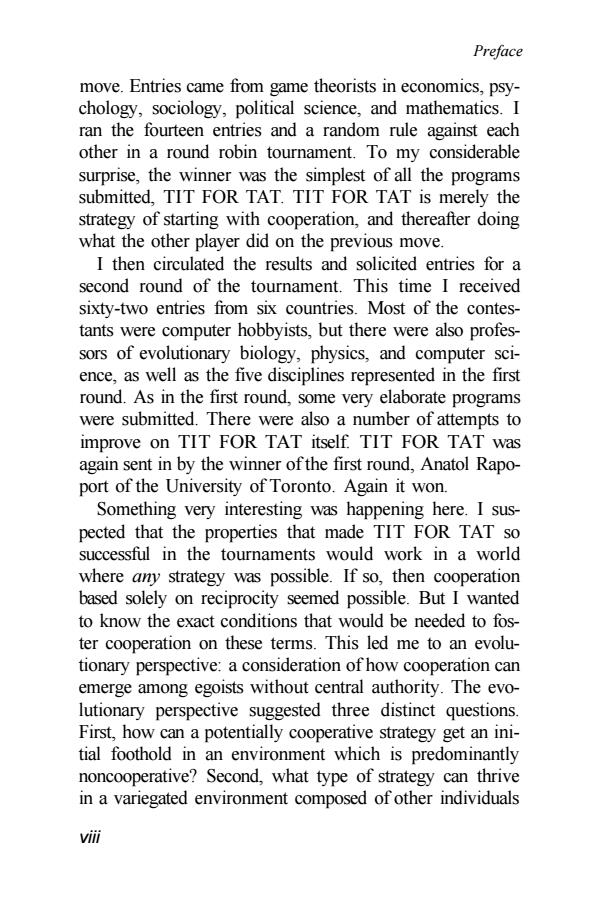正在加载图片...

Preface move.Entries came from game theorists in economics,psy- chology,sociology,political science,and mathematics.I ran the fourteen entries and a random rule against each other in a round robin tournament.To my considerable surprise,the winner was the simplest of all the programs submitted,TIT FOR TAT.TIT FOR TAT is merely the strategy of starting with cooperation,and thereafter doing what the other player did on the previous move. I then circulated the results and solicited entries for a second round of the tournament.This time I received sixty-two entries from six countries.Most of the contes- tants were computer hobbyists,but there were also profes- sors of evolutionary biology,physics,and computer sci- ence,as well as the five disciplines represented in the first round.As in the first round,some very elaborate programs were submitted.There were also a number of attempts to improve on TIT FOR TAT itself.TIT FOR TAT was again sent in by the winner ofthe first round,Anatol Rapo- port of the University of Toronto.Again it won. Something very interesting was happening here.I sus- pected that the properties that made TIT FOR TAT so successful in the tournaments would work in a world where any strategy was possible.If so,then cooperation based solely on reciprocity seemed possible.But I wanted to know the exact conditions that would be needed to fos- ter cooperation on these terms.This led me to an evolu- tionary perspective:a consideration of how cooperation can emerge among egoists without central authority.The evo- lutionary perspective suggested three distinct questions. First,how can a potentially cooperative strategy get an ini- tial foothold in an environment which is predominantly noncooperative?Second,what type of strategy can thrive in a variegated environment composed of other individuals viⅷPreface move. Entries came from game theorists in economics, psychology, sociology, political science, and mathematics. I ran the fourteen entries and a random rule against each other in a round robin tournament. To my considerable surprise, the winner was the simplest of all the programs submitted, TIT FOR TAT. TIT FOR TAT is merely the strategy of starting with cooperation, and thereafter doing what the other player did on the previous move. I then circulated the results and solicited entries for a second round of the tournament. This time I received sixty-two entries from six countries. Most of the contestants were computer hobbyists, but there were also professors of evolutionary biology, physics, and computer science, as well as the five disciplines represented in the first round. As in the first round, some very elaborate programs were submitted. There were also a number of attempts to improve on TIT FOR TAT itself. TIT FOR TAT was again sent in by the winner of the first round, Anatol Rapoport of the University of Toronto. Again it won. Something very interesting was happening here. I suspected that the properties that made TIT FOR TAT so successful in the tournaments would work in a world where any strategy was possible. If so, then cooperation based solely on reciprocity seemed possible. But I wanted to know the exact conditions that would be needed to foster cooperation on these terms. This led me to an evolutionary perspective: a consideration of how cooperation can emerge among egoists without central authority. The evolutionary perspective suggested three distinct questions. First, how can a potentially cooperative strategy get an initial foothold in an environment which is predominantly noncooperative? Second, what type of strategy can thrive in a variegated environment composed of other individuals viii